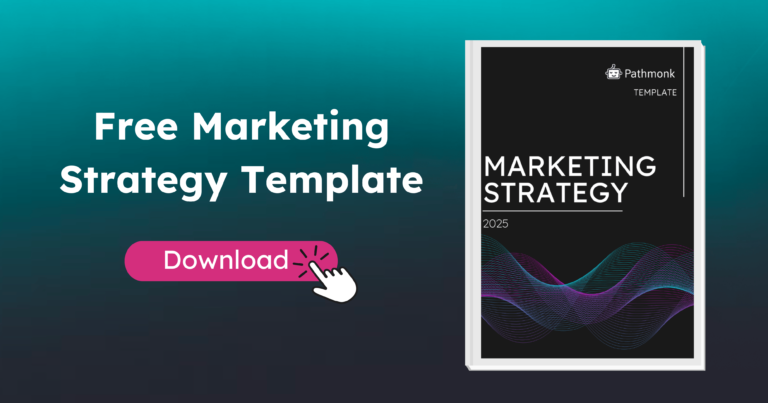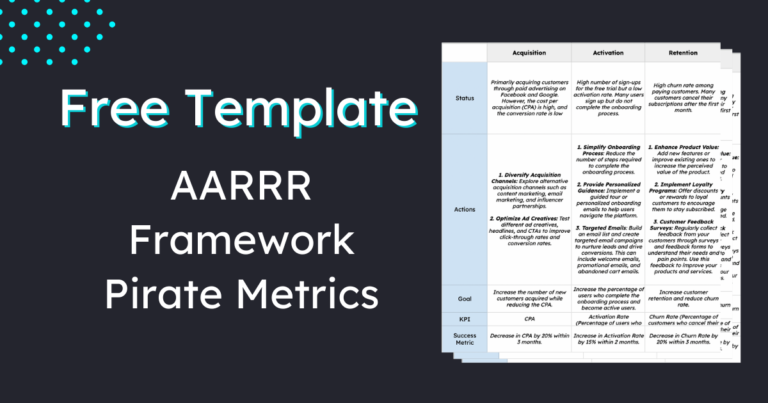
Most marketing strategies fail before they even start—not because of poor execution, but because they’re built on guesswork. Marketers jump into tactics without first nailing down the essentials: who they’re targeting, what they’re trying to achieve, and how they’ll measure success.
The result? Missed opportunities, wasted budgets, and frustration.
Let 2025 be the year to change that. Instead of rushing to adopt every new trend, it’s time to focus on building a strategy that works—step by step. This article will show you exactly how to do that in six simple, actionable stages, so you can spend less time scrambling and more time driving real results.
Table of Contents
1. Reflect on lessons from 2024
Every annual strategy starts with understanding where you stand—and that means taking a hard look at last year’s performance. Here you should be digging into the insights behind the data and using them to set a stronger course for the year ahead.
You can start this step by reviewing your key metrics from last year. Did your campaigns hit their goals? Where did they fall short? Look for patterns:
- High performers: Which channels, tactics, or campaigns drove the best results, and why?
- Underperformers: Identify the weak links. Was it a mismatch in audience targeting, messaging, or timing?
For example, maybe your email campaigns excelled in driving repeat purchases, but your social ads struggled to bring in new leads.
Remember to also take into account a broader market vision. What moves did your competitors make last year? Analyze their campaigns, messaging, and new initiatives to spot opportunities or threats. Tools like SimilarWeb or SEMrush can help you track their digital performance.
Now, while SWOT analysis shouldn’t take center stage, it’s still a handy tool for reflection. Revisit your previous SWOT to see how your strengths, weaknesses, opportunities, and threats have evolved. Update it with insights from last year’s performance to keep your strategy grounded in reality.
An updated SWOT analysis can look something like this:
Category | 2024 Insight | 2025 Adjustment |
Strengths | High-performing email campaigns | Invest in segmentation and personalization |
Weaknesses | Low engagement on social media ads | Test new ad formats and targeting options |
Opportunities | Competitor exit from a key market | Increase share of voice in that market |
Threats | Rising cost of paid ads | Diversify into lower-cost acquisition channels |
When creating annual marketing strategies, involve your team in this process. A brainstorming session can surface insights that data alone might miss. Your sales team may have noticed trends in buyer objections, or your customer success team might highlight common pain points.
With a clear understanding of your wins and misses, you’ll be ready to build a strategy that’s smarter and sharper than ever. On to step 2!
Key takeaways:
- Review last year’s performance to identify what worked and what didn’t.
- Analyze competitor actions for opportunities and threats.
- Revisit your SWOT to update strengths, weaknesses, opportunities, and threats.
- Collaborate with your team to uncover valuable insights beyond the data.
2. Set your marketing goals for 2025
Annual goals give your marketing strategy structure, ensuring everyone on the team knows where you’re headed and why. Effective goals inspire action and accountability.
One way to set your goals is by focusing on 1–2 primary goals—the big, overarching achievements that define success. Then, breaking them down into 2–4 supporting goals that tackle specific areas to help you get there. Here’s an example:
- Primary goal: Increase qualified leads by 25% by year-end.
- Supporting goals:
- Boost landing page conversion rates by 15%.
- Launch two co-marketing campaigns with partners.
- Create a lead nurture email sequence by Q1.
Primary goals set the vision, while supporting goals create the steps to achieve it.
While primary goals should always be SMART—specific, measurable, achievable, relevant, and time-bound—supporting goals can have some flexibility. Some supporting goals can look like “Complete website redesign by Q3,”. They are simply about moving forward.

The best marketing goals are those aligned with business outcomes. Whether it’s increasing revenue, improving retention, or expanding market share, make sure your marketing goals have a direct impact on what matters most to your organization.
Key takeaways:
- Focus on 1–2 primary goals and 2–4 supporting goals for the year.
- Use SMART criteria for primary goals to ensure they’re actionable and measurable.
- Align your goals with broader business outcomes to drive meaningful results.
3. Define the best tactics to achieve your goals
This is where brainstorming tactics come in. Here, it’s easy to get stuck just throwing ideas around, so remember to focus on organizing them within a proven framework.
Frameworks help you stay focused and ensure your tactics are comprehensive. One popular choice is AARRR (Acquisition, Activation, Retention, Referral, Revenue). Originally designed for startups, it’s perfect for breaking down each stage of the customer journey and identifying actionable touchpoints.
Alternatively, you can simplify things by focusing directly on the customer journey:
- Acquisition: How do prospects discover your brand?
- Engagement: How do you capture their attention?
- Conversion: What motivates them to take action?
Here’s an example: If your goal is to increase qualified leads, tactics might include offering gated content for lead capture, running retargeting ads for website visitors, and hosting webinars to nurture interest.
Keep in mind your tactics should be crystal clear and tied to measurable outcomes. Instead of “Use email marketing,” try “Launch a five-part email sequence targeting new sign-ups.” Instead of “Improve social media presence,” try “Create two Instagram Reels weekly to showcase product use cases.”
Key takeaways
- Use frameworks like AARRR or the customer journey to structure your brainstorming.
- Break down each stage of the buyer’s journey to identify actionable touchpoints.
- Ensure every tactic is specific and measurable.
4. Prioritize your marketing actions for 2025
You can’t do everything at once. It’s prioritization time! The goal here is to focus your energy and resources on the actions that will drive the biggest results. Enter the impact-resources matrix, a simple yet powerful tool for sorting through your options.
The matrix evaluates each tactic based on two key factors:
- Impact: How significantly will this tactic contribute to achieving your goals?
- Resources: What will it cost you to execute this tactic in terms of time, money, or team effort?
Your impact-resources matrix can look something like this:
High Impact, Low Effort | High Impact, High Effort |
Developing an interactive product demo | |
Adding personalized CTAs to landing pages |
Low Impact, Low Effort | Low Impact, High Effort |
Minor design updates on blog headers | Daily content creation for social media |
Here’s how you can use this matrix to make decisions about your annual marketing activities:
- Focus on “no brainers”: Start with the high-impact, low-effort quadrant. These are your quick wins—simple actions with outsized results. For example, optimizing your website CTAs or running retargeting ads.
- Plan for big wins: Next, tackle high-impact, high-effort projects. These require more resources but deliver long-term value, like creating a robust lead nurture sequence or launching a webinar series.
- Trim the fat: Avoid low-impact, high-effort tactics unless they’re critical for reasons beyond immediate ROI.
And don’t treat the matrix as a one-and-done exercise. As you implement tactics, revisit the matrix to adjust based on new insights or shifts in priorities.
Key takeaways:
- Use the Impact-Resources Matrix to prioritize tactics that deliver the biggest results.
- Start with high-impact, low-effort ideas to build momentum.
- Reassess priorities regularly to stay adaptable and focused.
5. Build a balanced budget
A solid budget ensures your strategy is grounded in reality, balancing ambition with available resources. Base your budget on the tactics you’ve prioritized. High-impact activities should receive the largest share of your funding, while experimental projects can have a smaller reserve.
Example Breakdown:
Category | Percentage of Budget | Examples |
Core campaigns | 50% | Paid ads, content marketing, email campaigns |
Strategic investments | 30% | Website redesign, webinars, major launches |
Experimental tactics | 10% | Emerging channels, CRO testing |
Tools and technology | 10% | CRM, analytics platforms, automation tools |
For each tactic, calculate expected expenses, including creative production, ad spend, tools, and team hours. Historical data from past campaigns can help you forecast more reliably.
It’s also important to set aside a portion (5-10%) of your budget for unplanned opportunities or adjustments. Markets change, and having financial flexibility allows you to pivot when needed.
Key takeaways:
- Allocate the largest portion of your budget to high-impact tactics.
- Use historical data to estimate costs and forecast accurately.
- Reserve 5–10% for flexibility to adapt to new opportunities.
6. Create a roadmap for your 2025 marketing strategy
This step ensures that everyone on your team knows what needs to happen, when, and how to prioritize their efforts. Think of it as your strategy’s playbook—clear, actionable, and goal-oriented.
Begin by setting key milestones that align with your goals. These are high-level achievements that mark significant progress, such as launching a campaign or completing a major project.
- Q1: Launch lead generation webinar series.
- Q2: Complete website redesign for higher conversions.
- Q3: Implement a referral program.
- Q4: Review annual metrics and refine for the next year.
Once milestones are set, break them into smaller tasks with clear deadlines and ownership. Use project management tools like Asana, Trello, or Monday.com to track progress.
Here’s a simple example of a task roadmap:
Task | Owner | Deadline |
Design landing page for webinar | Creative Team | January 15, 2025 |
CRM Specialist | January 22, 2025 | |
Launch webinar promotion ads | Paid Ads Manager | January 25, 2025 |
Ambitious timelines are great, but only if they’re achievable. Factor in your team’s capacity, external dependencies, and potential delays. A roadmap that accounts for reality is far more effective than one based on wishful thinking.
A roadmap isn’t set in stone. Use it as a guide, but be ready to adjust as priorities shift or unexpected opportunities arise.
Key takeaways:
- Set quarterly milestones that align with your goals.
- Break milestones into actionable tasks with clear deadlines and ownership.
- Use project management tools to keep everyone aligned and accountable.
Why You Need Pathmonk On Your 2025 Marketing Strategy
With Pathmonk you can not only convert +180% more customers with website personalization, but also optimize your 2025 marketing strategy with access to unique customer journey insights and a cross-channel impact that increases your overall marketing ROI.
Increase +180%
leads
demos
sales
bookings
from your website with AI
Get more conversions from your existing website traffic delivering personalized experiences.

We’re talking about creating high impact with low effort. Pathmonk takes little to no time from your marketing team and delivers:
- Smart customer journey analytics: Pathmonk enables you to understand how your prospects behave, without traditional cookies. Get smart insights reports, the easy way.
- Personalized shopping experiences: Pathmonk dynamically adapts your website content to each visitor’s intent, creating tailored interactions that boost engagement and conversions;
- Increased lead generation: Pathmonk captures high-intent leads with AI-driven experiences, delivering better-qualified prospects and shortening your sales cycles.
Book your product tour today and increase your conversion rate up to 8x by January 2025! Or have a look at this interactive demo to learn more – without any sales calls 😉







